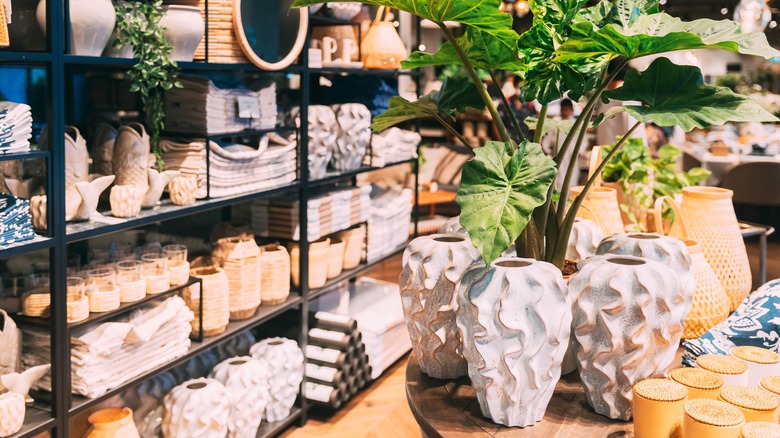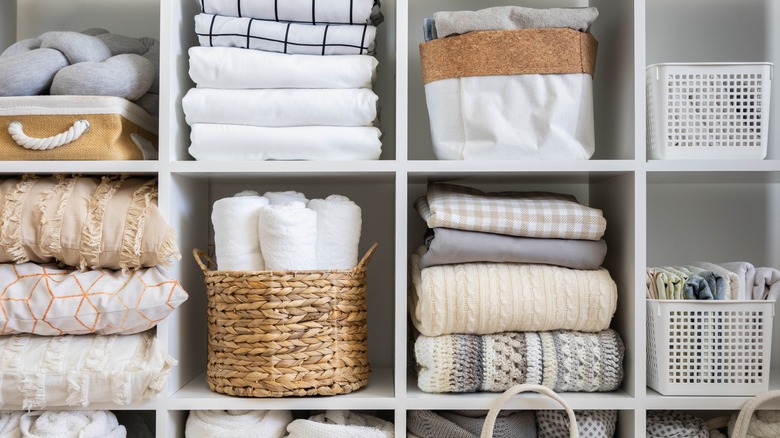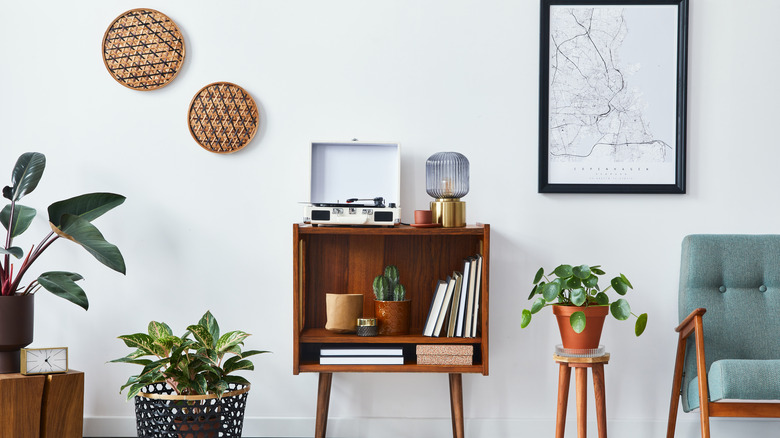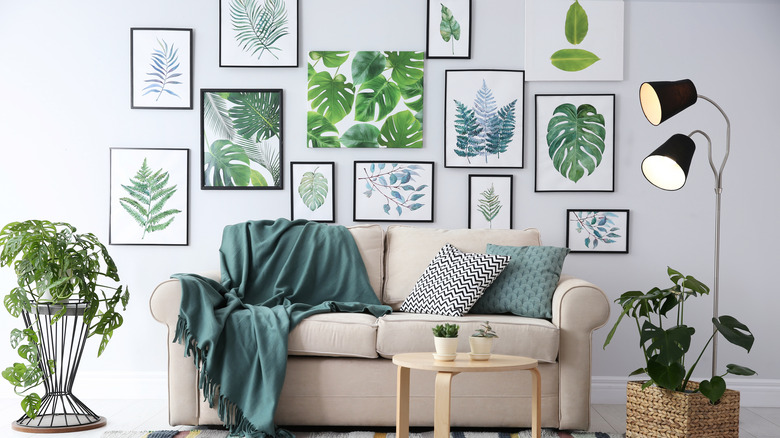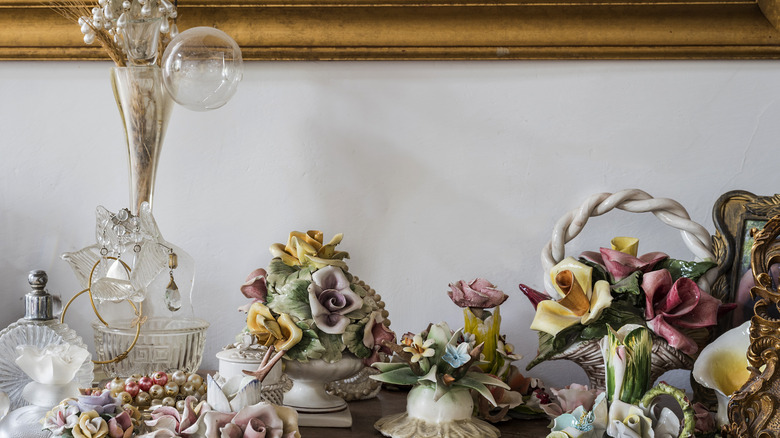5 Tips To Avoid Overdecorating Your Home
Whether your approach to decor is minimalist, maximalist, or somewhere in between, modern life can make it easy to fall into overdecorating your spaces. If you see that your living room is starting to resemble an attic or store display, you might be starting to get fed up with the clutter. Overdecorating can be the result of accumulating too many things, including items we purchase ourselves, others we inherit or are gifted, and then those that we outgrow in terms of style and trends but haven't gotten rid of. According to LivSpace, a key determining indicator you've fallen prey to overdecoration is when you enter a space and immediately feel overwhelmed.
A tendency to overdecorate might be the result of too much stuff, or simply the result of not arranging it in a way that feels balanced and harmonious. Whatever your style, there are several key things to think about, sometimes before you even bring something new into your space, that will help you navigate the tricky relationship between too much and just enough.
1. Be intentional
Sometimes the best decor decisions and planning happen before items even enter our homes. Planning goes a long way toward avoiding overdecorating mistakes, as do sound, intentional decisions on what can be accommodated in a given space. By evaluating what we already have and considering carefully what we would like to find before shopping, we can better grasp our current needs.
Avoid impulse and "good enough" purchases — those decisions we often make because we cannot afford or find the very thing we truly want. This might mean passing on a major furniture purchase or dining room table until we find exactly what we want and need. Once we've sprung for a purchase and have it home, often we regret not choosing the long-coveted piece. And once it's home, it's harder to part with it or swap it out once the decision and investment have been made. Also, keep in mind that the smallest changes can often make the biggest difference, according to The House of Silver Lining. Instead of immediately buying a lot of stuff for a whole new decor scheme, make small gradual changes that allow you to course correct or adapt.
2. Storage and organization
One key way to avoid overdecorating our spaces is to make sure everything has a place and that there's a place for everything. It becomes much easier to store things away out of sight if we have a dedicated spot for them. This includes holiday ornaments, sentimental items, or other items that only need to be displayed seasonally. According to Thrifty Decor Chick, a well-appointed storage system can help you instantly see what you have and what you need, so you avoid buying duplicates or more things you have to find room for. Without a good place to store them, these things have a way of incorporating their way into our decor whether we want them to or not.
Some of the best storage solutions are those that fit within your decor in an attractive way and/or are so beautiful you want to keep things well organized. Make use of pretty baskets and boxes to store things out of sight when not in use. This includes larger items, but also things like cords, chargers, and remotes. Plastic storage bins are a good option in places like basements and garages where they can protect things from dampness and pests. Also, consider spaces that are mostly underused as possible storage spots, including the nook under the stairs or above existing dropped cabinets in the kitchen.
3. Beauty and function
There are two main kinds of decor items we have in our houses — those that fulfill a simple function like a bookshelf or plant stand and those that we love to have around because we are attracted to their beauty or style. These latter things include artwork, accent pieces, and sentimental items. Sometimes, an item or element can fulfill both functions, which leads to a near-perfect relationship between form and function.
Consider each item in your home and why it's there. Thick drapes may not be your favorite but they provide necessary privacy. A couch may not be the most attractive but fulfills the seating and comfort needs of your family. A large television may not be beautiful but fulfills very practical entertainment needs. Find ways to make functional things beautiful and vice versa. A comfy, durable couch can be transformed with slipcovers. New drapes can provide both beauty and privacy. In addition, stylish things can also be made functional, like an antique record cabinet that doubles as storage for books and plants. The items that are both beautiful and functional often form the perfect balance, according to Capturing Wonderland.
4. White space
Even the most maximalist interiors need a place for the eyes to rest before they become a little overwhelming. Consider the way the viewer experiences items in the home and try to avoid drawing the gaze in too many directions without a pause. Not only will your space look more balanced and intentional, but your decor items will be given their due and draw the necessary focus.
Instead of scattering a large collection of items around your home, consider grouping them together with substantial amounts of blank or white space in between. A gallery wall has far more impact than the same images spaced out along all four walls of a room. An assemblage not only draws attention and makes interesting juxtapositions, but it also gives the areas around the gallery wall space to breathe. Also, consider the balance of elements in the assemblage, which can benefit from giving each piece its due white space around the perimeter, according to Cramer Imaging. A single collectible, knick-knack, or piece of memorabilia draws attention much more readily when encountered as a tableau or still life with other similar or complementary objects. Keep in mind that, according to News24, the best groupings are usually odd numbers of elements like 3, 5, or 7 rather than even ones.
5. Rotation
If you have many beautiful things, well-loved or merely functional, it may become difficult to make everything work together cohesively. For collectors particularly, or those with a lot of cherished items like heirlooms and antiques, it can be especially hard to draw a line when it comes to some of our favorite items. If you feel like you're struggling to decide how much is too much, consider rotating your favorite items or collections.
Much as we do with holiday decor and seasonal wardrobes, rotating can be a great compromise if you have the space to store things. Storing them avoids having to discard or give treasured items away. In addition, switching things out every so often, according to Eclectic Girl Designs, keeps rooms fresh and allows us to experience things anew each time they are put out. This can work excellently for things like collectibles, but also for more functional items like dishware, bedding, and throw pillows.

